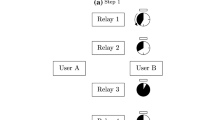Abstract
In this paper, the analytical expressions for the outage probability of different decode-and-forward (DF) relaying strategies for two-source two-destination networks are evaluated allowing an investigation of their effectiveness in energy saving to be determined. Each source node transmits data to an interested destination node with the help of the remaining source node in a cooperative DF manner. Specifically, we consider four DF protocols, including repetition DF (RDF), parallel DF (PDF), network coding-based RDF (NC-RDF), and dirty paper coding-like network coding-based PDF (DPC-NC-PDF). The closed-form expression of the outage probability for each protocol is derived at high signal-to-noise ratio. The results show that the DPC-NC-PDF protocol achieves the best performance while the NC-RDF protocol is better than both the RDF and PDF protocols with proper linear NC coefficients. All the DF protocols are shown to achieve diversity order one and the highest multiplexing gain is achieved with the NC-RDF and DPC-NC-PDF protocols. Finally, simulation results are presented to verify the analytical findings and show the system throughput comparison of various DF protocols.
Similar content being viewed by others
References
Sendonaris A., Erkip E., Aazhang B. (2003) User cooperation diversity—Part I. System description IEEE Transactions on Communications 51(11): 1927–1938
Sendonaris A., Erkip E., Aazhang B. (2003) User cooperation diversity—Part II. Implementation aspects and performance analysis, IEEE Transactions on Communications 51(11): 1939–1948
Laneman J., Tse D., Wornell G. (2004) Cooperative diversity in wireless networks: Efficient protocols and outage behavior. IEEE Transactions on Information Theory 50(12): 3062–3080
Loa K., Wu C. C., Sheu S. T., Yuan Y., Chion M., Huo D. (2010) IMT-advanced relay standards [WiMAX/LTE update]. IEEE Communications Magazine 48(8): 40–48
Yang Y., Hu H., Xu J., Mao G. (2009) Relay technologies for WiMax and LTE-advanced mobile systems. IEEE Communications Magazine 47(10): 100–105
Garcia, I., Sakaguchi, K., & Araki, K. (2008). Cell planning for cooperative transmission. In Proceedings of IEEE WCNC’08, Las Vegas, USA (pp. 1769–1774).
Sheng Z., Leung K., Ding Z. (2011) Cooperative wireless networks: From radio to network protocol designs. IEEE Communications Magazine 49(5): 64–69
Moh, S. (2008). Two cooperation models and their optimal routing for cooperative diversity in wireless ad hoc networks. In Proceedings of IEEE ISWCS’08, Reykjavik, Iceland (pp. 57–61).
Sharma S., Shi Y., Hou Y., Kompella S. (2011) An optimal algorithm for relay node assignment in cooperative ad hoc networks. IEEE/ACM Transactions on Networking 19(3): 879–892
Sun L., Zhang T., Lu L., Niu H. (2009) Cooperative communications with relay selection in wireless sensor networks. IEEE Transactions on Consumer Electronics 55(2): 513–517
Elhawary M., Haas Z. (2011) Energy-efficient protocol for cooperative networks. IEEE/ACM Transactions on Networking 19(2): 561–574
Chen Y., Teo J., Lai J., Gunawan E., Low K.S., Soh C.B. (2009) Cooperative communications in ultra-wideband wireless body area networks: Channel modeling and system diversity analysis. IEEE Journal on Selected Areas in Communications, 27(1): 5–16
D’Errico, R., Rosini, R., & Maman, M. (2011). A performance evaluation of cooperative schemes for on-body area networks based on measured time-variant channels. In Proceedings of IEEE ICC 2011, Kyoto, Japan (pp. 1–5).
Dimakis A., Prabhakaran V., Ramchandran K. (2006) Decentralized erasure codes for distributed networked storage. IEEE Transactions on Information Theory 52(6): 2809–2816
Dimakis A., Ramchandran K., Wu Y., Suh C. (2011) A survey on network codes for distributed storage. Proceedings of the IEEE 99(3): 476–489
Ahlswede R., Cai N., Li S. Y., Yeung R. (2000) Network information flow. IEEE Transactions on Information Theory 46(4): 1204–1216
Koetter R., Medard M. (2003) An algebraic approach to network coding. IEEE/ACM Transactions on Networking 11(5): 782–795
Katti, S., Katabi, D., Hu, W., Rahul, H., & Medard, M. (2005). The importance of being opportunistic: Practical network coding for wireless environments. In Proceedings of Allerton’05. Montecillo, Illinois, USA.
Zhang, S., Liew, S. C., & Lam, P. P. (2006). Hot topic: Physical-layer network coding. In Proceedings of ACM MobiCom’06, Los Angeles, CA, USA (pp. 358–365).
Katti, S., Gollakota, S., & Katabi, D. (2007). Embracing wireless interference: Analog network coding. In Proceedings of ACM SIGCOMM’07, Kyoto, Japan (pp. 397–408).
Katti S., Rahul H., Hu W., Katabi D., Medard M., Crowcroft J. (2008) XORs in the air: Practical wireless network coding. IEEE/ACM Transactions on Networking 16(3): 497–510
Zhang J., Ben Letaief K., Fan P., Cai K. (2009) Network-coding-based signal recovery for efficient scheduling in wireless networks. IEEE Transactions on Vehicular Technology 58(3): 1572–1582
Louie R., Li Y., Vucetic B. (2010) Practical physical layer network coding for two-way relay channels: Performance analysis and comparison. IEEE Transactions on Wireless Communications 9(2): 764–777
Laneman, J. (2006). Co-operative diversity: models, algorithms, and architectures. In Cooperation in wireless networks: principles and applications. Springer, New York (2006).
Fawaz N., Gesbert D., Debbah M. (2008) When network coding and dirty paper coding meet in a cooperative ad hoc network. IEEE Transactions on Wireless Communications 7(5): 1862–1867
Costa M. (1983) Writing on dirty paper (corresp.). IEEE Transactions on Information Theory, 27(3): 439–441
Author information
Authors and Affiliations
Corresponding author
Rights and permissions
About this article
Cite this article
Vien, QT., Stewart, B.G. & Nguyen, H.X. Outage Probability of Regenerative Protocols for Two-Source Two-Destination Networks. Wireless Pers Commun 69, 1969–1981 (2013). https://doi.org/10.1007/s11277-012-0673-8
Published:
Issue Date:
DOI: https://doi.org/10.1007/s11277-012-0673-8




